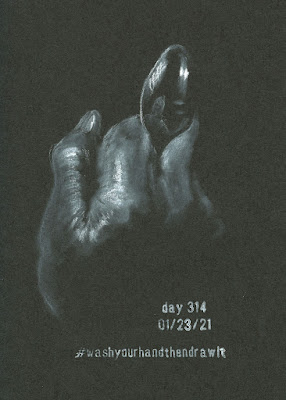 |
A new function for an old-school icon: the Bic
4-Color 3+1 |
I seem to have come full circle.
Several years ago when I had been dabbling in sketching with
ballpoint ink but hadn’t yet embraced it, I tried using a Bic 4-Color Pen.
As a teenager, I thought it was the coolest thing ever to have four ink colors
in one compact pen. First introduced in 1970 by French entrepreneur Marcel Bich,
it’s nostalgic to me. Many decades later, the iconic pen was still cool in my
continual search for compact, portable sketch materials, so I gave it a shot.
As I said, I hadn’t yet embraced ballpoint ink, and the pen body itself seemed
cheesy and clumsy, especially the slidey things used to select the ink colors.
(Apparently my standards in product design had come up a few notches since I
was 13.) I rejected it almost immediately.
The concept of a multi-pen still had sketch kit potential,
however, so I upgraded to a Uni Jetstream 4 & 1 when I observed my
first National Ballpoint Pen Day. With far superior design and construction,
the Japan-made Jetstream’s body feels more substantial than a Bic 4-Color, and
its slidey things move smoothly and engage flawlessly. The Jetstream is still
my favorite ballpoint to write with. Unfortunately, the ink it contains is a
newfangled “hybrid” that delivers a smoother, blob-free writing experience but,
alas, is just not the same as blobby, oily Bic ink. I still keep it in my bag
to sign papers or jot quick notes, but I don’t enjoy drawing with it.
(Incidentally, in case you are uninitiated, the Japanese have gone hog wild in
the multi-pen industry. A quick search on JetPens brings up literally
hundreds of options. You’re welcome . . . see you in a few hours.)
 |
| From left: a classic 4-Color, one with a highlighter, one with "fashion" colors |
Fast-forward a couple of years to InkTober, when I
came to thoroughly embrace drawing with Bics. Something about that sticky,
oil-based ink makes it the “pencil of pens”: It’s pressure-sensitive and
can be layered gradually like graphite. Any pen that acts like a pencil is good
by me!
 |
| A 0.7mm pencil component makes this Bic 4-Color unique. |
Recently a new Bic 4-Color came to my attention: the 4-Color
3 + 1. Actually, it has only three ink colors, and the fourth component is
a mechanical pencil (the Uni Jetstream also has a pencil unit, as designated by
the “& 1” in its name). In general, I’m not a fan of drawing with
mechanical pencils, but having a pencil option with my beloved Bic ink does
make this Swiss army knife of drawing tools more versatile. It was worth a try.
As soon as I got it, I noticed a difference. The body shape is
slightly different from the classic 4-Color and – more significantly – the mechanism
of the slidey things is much smoother and operates better. Reading the fine
print on the packaging, I learned that while most Bic 4-Colors are still made
in France, the model with the pencil component is made in Japan. Interesting!
Also interesting is the Bic’s 0.7mm lead instead of the more
typical 0.5mm lead found in other multi-pens. I have a heavy-handed habit of
snapping most 0.5mm leads, so this was good news to me. The included lead feels
like HB. For sketching, I prefer a softer one, so I’m going to swap it out for
a 2B (the softest grade I could find in 0.7mm). It’s reassuring not to need a
sharpener, which I haven’t carried in my slim pandemic bag in a year.
The ink refills – red, black and blue – are standard medium
points that are my favorite for drawing.
 |
| Capped eraser |
 |
| Much-improved slidey things! |
 |
| Blue, red, black inks |
 |
1/26/21 Bic 4-Color 3 + 1, Uni Pin brush pen and colored
pencil in Field Notes Signature |
As much as I enjoy sketching with a ballpoint or graphite
pencil, they can be more time-consuming than watercolor pencils or markers because
the best use of them involves large areas of hatching. I’m not inclined to do
that kind of sketching on the street, so I’ve been using the Bic 4-Color 3 + 1 in
conjunction with the Uni Pin brush pen. The latter does the heavy lifting on darker
values quickly. I like the combo.
With red and blue the only colors besides black, this so-called
4-Color isn’t as colorful as I would like it to be. Still, during these grayest
days of winter, it’s accurate for neighborhood sketching. I have some doubts
about how well the 4-Color 3 + 1 will serve my minimalism challenge needs,
but it’s fun to have a “new” tool to try. And regardless of how well it
works for my challenge, it’s great to see an improved body for an old-school
tool.




















































